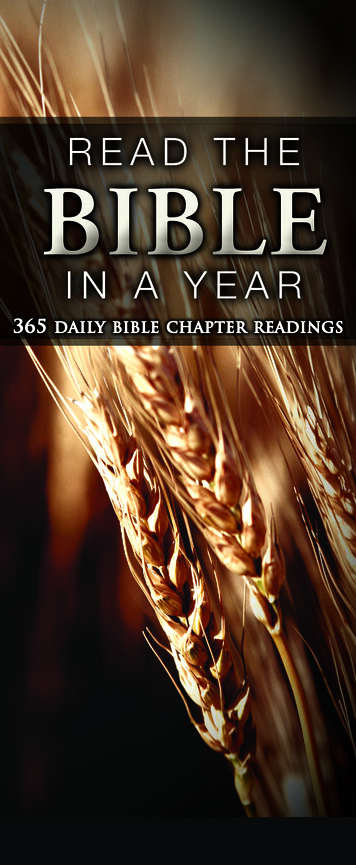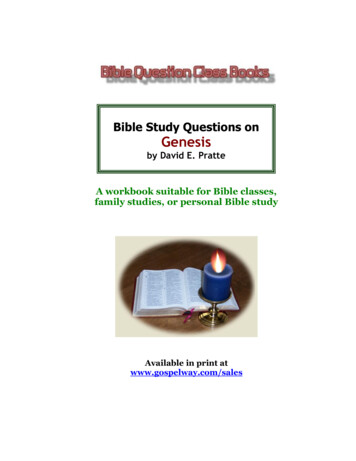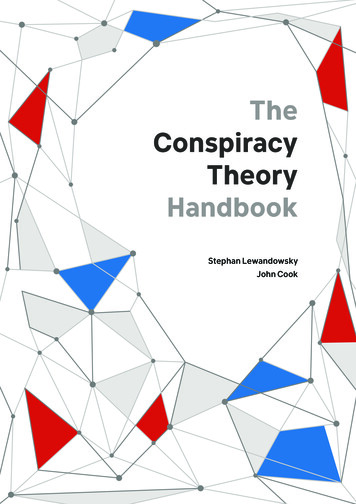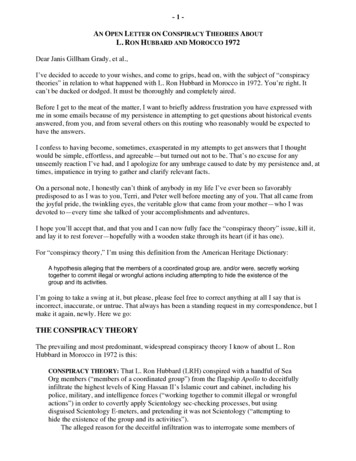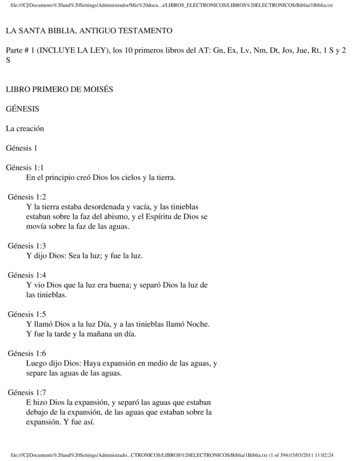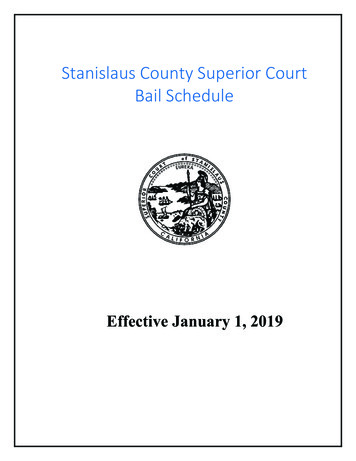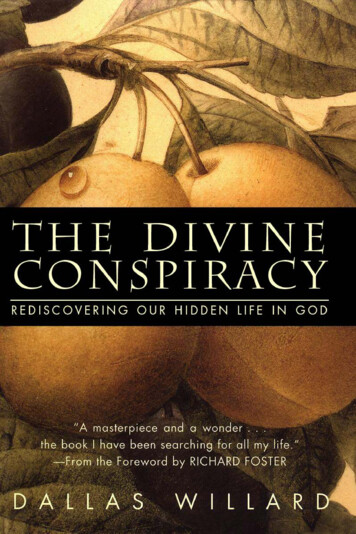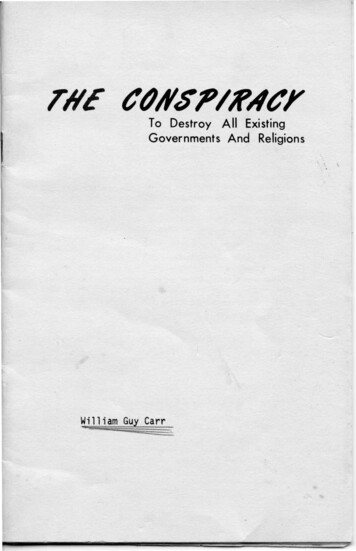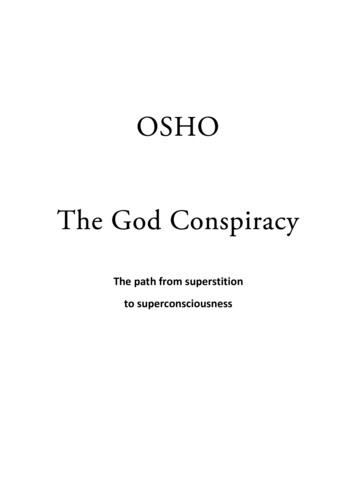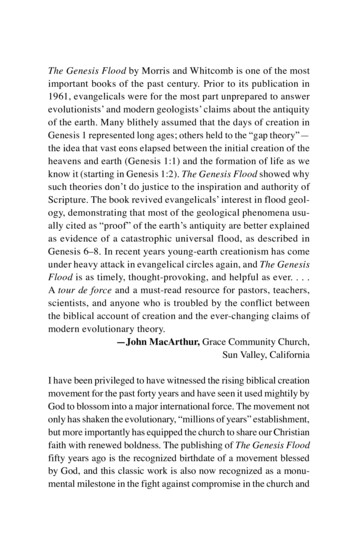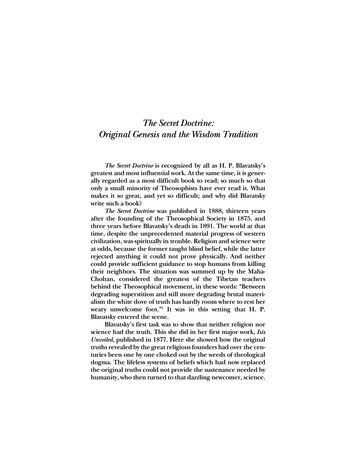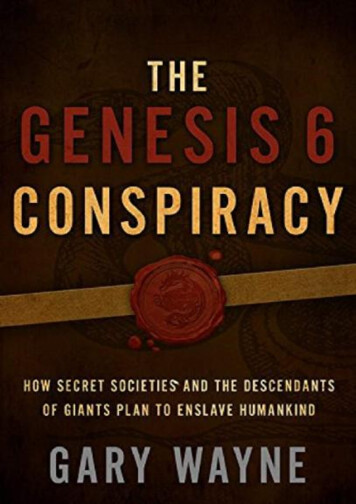
Transcription
2014 by Gary Wayne. All rights reserved.Trusted Books is an imprint of Deep River Books. The viewsexpressed or implied in this work are those of the author. Tolearn more about Deep River Books, go online towww.DeepRiverBooks.com.No part of this publication may be reproduced, stored in aretrieval system or transmitted in any way by any means—electronic, mechanical, photocopy, recording or otherwise—without the prior permission of the Publisher, except asprovided by USA copyright law.Unless otherwise noted, all Scriptures are taken from the HolyBible, New International Version , NIV . Copyright 1973,1978, 1984 by Biblica, Inc. Used by permission an.comScripture references marked GNT are taken from the GoodNews Bible With Deuterocanonicals/Apocrypha Translation (Today’s English Version, Second Edition), copyright 1992American Bible Society. All rights reserved.Scripture references marked NRSV are taken from The AccessBible, New Revised Standard Version with the Apocrypha,Oxford University Press, New York, NY, 1999. Used bypermission. All rights reserved.The NIV Study Bible New International Version Red LetterEdition, Copyright 1985, The Zondervan Corporation,Copyright 1973, 1978, 1984 by International Bible Society.Good News For Modern Man, The New Testament In Today’sEnglish 3rd Edition, American Bible Society, New York, NY,1966.Scripture references markedJames Version of the Bible.KJVare taken from the KingQur’an quotations are from The Qur’an, Translation by M. A.S. Abdel Haleem, Oxford University Press, 2005.ISBN 13: 978-1-63269-290-0Library of Congress Catalog Card Number: 2011960135
PrefaceSECTION I: The Antediluvian EpochThe Age of Great Heroes1. Heroes of Old2. The Daughters of Cain3. The Sons of God4. The Giants of Antiquity5. The Schism of Antediluvian Freemasonry6. Enoch and Hermes7. Enoch the Evil8. Royal Bloodlines9. Antediluvian Masonry and the Seven Sacred Sciences10. Enochian Mysticism11. The Great Deluge12. Azazel: Leader of theWatchers13. Lucifer’s RevengeSECTION II: The Golden AgeThe Global Testimony for the Other Race14. The Black Heads15. Isis, Ishtar, Gaea, and Ninkhursag16. The Great World Myth17. Atlantis18. Zep Tepi: The First Time19. Echoes from Atlantis, Sumer, and Mu20. The Seven Sages of Atlantis21. TheEpic of Gilgamesh22. Deucalion, Manu, and SethSECTION III: The Descendants of AnakBloodlines and Covenants23. The Raphaites and the Amorites24. Sodom and Gomorrah25. The Amalekites26. Jethro and Caleb27. Nimrod28. The People of the Plain
29. The Tower at Babel30. The Original Great White Brotherhood31. Forging the Nation of Destiny32. The Nephilim Wars33. The Holy Covenant34. Jericho35. Curse of the Amalekites36. King Saul and King David37. David and Goliath38. The AvvitesSECTION IV: The Terminal GenerationThe Time of Jacob’s Trouble39. Nothing New Under the Sun40. The New Man41. The New Age of Aquarius42. The Sign of Noah43. The Godless Generation44. Babylon City45. Reflections from Within the Third Reich46. The False Prophet47. The Disciples of Light48. The Alien Phenomena49. The Mother of All Sorceries50. Spirit of the Antichrist, the Beast51. The New Nimrod52. The Rapture Tragedy53. AdonaiSECTION V: Rex DeusBloodlines of the Grail54. The Jerusalem Church55. Sex, Lies, and Fairy Tales56. The Knights Templar57. The Priory of Sion58. The Sinclairs59. St. Bernard and the Benedictine Monks60. The Invisible College61. Legends of the Holy Grail62. Joseph of Arimathea63. Scota and Temar64. The Kings of Camelot65. The Merovingians66. The Trojans
67. The House of Stuart68. Guardians of the AntichristSECTION VI: Rendezvous with DestinyAnatomy of a Global Conspiracy69. Novus Ordo Seclorum70. Inside Freemasonry71. The Thirty-Third Degree72. The Rothschild-Rockefeller-Morgan Axis73. Secret Societies and the New Age of Atlantis74. The Illuminati75. Global Gnosticism76. A Thousand Points of Light77. The Rosicrucians78. The New Age MillenniumSECTION VII: The House of DragonBloodlines of the Prehistoric Giants79. The Fairy Kingdoms80. Ordo Draconis81. Serpents and Dragons82. Leviathan83. The Bull Cult of Melchizedek84. The Essenes85. Moses, Akhenaten, and the Armana Dynasty86. Joseph87. Abraham, Esau, and Ishmael88. The Kings of Nimrod and Ham89. Ham and Japheth90. The Blood Drinking Kings of Kish91. The Antediluvian Dragon Court92. Adam and Cain93. LilithSECTION VIII: The Gene of IsisBloodlines of the Fairies94. The Grail Cauldron of Fairies, Annwyn, and Atlantis95. The Fairy Lords of the Tuatha Denaan96. The Royal House of the Scythians97. The Antediluvian Testimony98. The Khem of MendesEpilogue: What Must Take Place Will Take PlaceBibliographyEndnotes
What would you do if you discovered the end times and theAntichrist were somehow interconnected with giants, modernconspiracy theories, aliens, vampires, secret societies, and fairies?What would you do if you learned refugees from another Apocalypsedutifully encoded dire warnings into worldwide testimonies preservingthem for a specific generation, this generation concerning an ancientand ongoing conspiracy to enslave humankind? Would you simplywalk away? Seriously, would you really tell anyone? Or would youdisregard the personal onslaughts that would be sure to follow theexposé of such controversial discoveries?My spiritual pursuit has been analogous to my motivation to writethis book. I have pursued my beliefs with all the energy containedwithin my spirit, even though at times I have dropped the quest withsuch coldness that I wondered whether or not it had ever permeated myconsciousness. And yet I returned, not perceiving why or how. It isakin to a haunting voice, whispering in the wilderness, drawing evercloser, yet continually evading me until confusion once more sets in.Just when I no longer can hear the calling, it once more permeates thedarkness drawing me back. This thirty-year journey has taught me thatif I was not a Christian contrarian, this composition would not havebeen started, completed, or published.Frankly, mysteries contained within Scripture and other ancientsources do not pastorally coexist with contemporaneous, secularscience during this season of reason suppressing faith. Nor do thesemysteries pastorally coexist with status quo dogma offered by mostmonotheistic religions. Sadly, most of monotheism ignores themessage from the Messiah to resolutely uphold truth and grace,1 nomatter the times or the implications.Hence, this unsettling quest will teleport you to an unfamiliar placesnared somewhere between faith and reason. This quest will challengeyour perceptions of what you thought the Bible said, as well astransform your current view of the world as dictated by modernsecularism.
This quest tenders disquieting questions, exposing dissonantconclusions concerning Scripture and the currently accepted seculardogma of antiquity. Prehistory is submerged in foggy waters, anunnerving conundrum for historians, who demand scientificbenchmarks buttressed with evidence and archaeologicalcorroboration. But if we whisk away the confusing haze, clarityemerges about the first written history, revealing key relationships andinstructions for this generation.We will reexamine Genesis, the balance of the Bible, and otherscriptures as if they were just discovered, transforming illogical andpreconceived notions regarding creation and the ancient epochs anddisclosing historical imperatives that have rippled down through thegenerations. The reader will learn what has taken place, what is takingplace, and what must take place. Therefore, I urge you to keep a Bibleand the footnotes at your fingertips to validate the accuracy andcontext of the vast amount of Scripture applied in this work which isset alongside the volumes of secular and polytheist testimonies.A Greek historian and philosopher, Plutarch, circa 46–125 C.E.employed more than 250 works from additional ancient authors, ofwhich many have been lost to history,2 in his quest to record ancienthistory as it was viewed from his milestone in history.Plutarch wroteregarding the difficulties beyond a certain ancient historical point ofselecting a spot of sure footing, where reason is able to continue thereach back into real history: “ beyond this there is nothing butprodigies and fictions, the only inhabitants are the poets and inventorsof fables; there is no credit or certainty any farther.”3 Scripture will beour historical foundation stones for certainty and credibility, for just asC. S. Lewis has noted that whatever else the Gospels might be, theyclearly are not legend;4 and in this writer’s opinion, they are accurate,monotheist history.With this in mind, understand that most scriptural principleseventually and without explanation return to the beginning, Genesis.Genesis methodically tilled the soil for the balance of the Bible andhumankind, sowing the seeds for the many doctrines and plotscultivated throughout Scripture. Once the plots and doctrines are fullydeveloped, one finds oneself inexplicably returning to Genesis to fullycomprehend the insights, revisiting the little known and misunderstoodagrarians of Genesis. This book begins in Genesis and ends in Genesis.Genesis is both the cornerstone and the Rosetta Stone for Scripture,decoding the true history of humankind, our future, and this quest.In this spirit then, the Bible ought to be viewed as a reliable andaccurate believer’s history, but not a document designed to meet
current, secular standards for history or archaeological research. Goddid not intend Scripture to be an encyclopedia, nor did He intend it tobe a clinical, historical, scientific handbook. Moreover, Scripturefrustrates science’s need for visible, undeniable proof complete withcorroborating reference points. Conversely, God designed Scripture tohold the history of a people’s God, their religion, and the tribulationsof their Holy Covenant. Scripture was written to nourish faith, notreason. It is through this lens we must read it—just as it was written ina literal sense to the faithful believers, not through the lens of godless,secular cynics or interpretive, mystical revisionists.We will enlist the historian Josephus as well as Albert Mackey’slegends of Freemasonry to investigate the mysteries of prehistory. Wewill put these alongside numerous Gnostic gospels, including the NagHammadi Library; the Dead Sea Scrolls; and a host of historians,authors, and clerics, including a broad sweep of legends, mythologies,and religious literature from around the world, drafted for anecdotalbackdrop. All impart important testimonies, redefining otherwiseunaccountable ancient civilizations, their misconstrued religions, andtheir perplexing conundrums. Indeed, as C. S. Lewis once noted, mythpoints to reality.5Accordingly, we will often consult Enoch. His visions wererecorded in several Gnostic gospels, alongside the famous book ofEnoch discovered in Ethiopia in 1785 C.E. and copied by a famousFreemason named James Bruce. From these and other Gnostic sources,Bruce produced the Codex Bruciannus, one of the few Gnosticreference books until the discovery of Nag Hammadi.6 Bruce was adirect descendant of the famous historical figure Robert the Bruce, aswell as a descendant from an obscure Jewish order of priests from thetime of Jesus,7 the Essenes.The Nag Hammadi texts were discovered in Egypt in 1945 C.E., andthey date back to 290–346 C.E.8 The Nag Hammadi Library wascomposed while the Roman Catholic Church purged heretical Gnosticmovements; the library’s purpose was to pass onto future generationsthe knowledge to free humans from their earthly bondage through thecult of knowledge.9 Hence, the Tripartite Tractate refers to TheOrganization, a secretive and mysterious organization that fightsagainst the dark forces of ignorance, while preserving ancientknowledge and building impressive monuments to represent spiritualplaces10 (themes that dominate this composition). Always rememberthat behind the thick, steel door of superficial history taught by theeducated elite sleeps an obscure version that elucidates the enigmaticevents of history. Regrettably, there is a shadowy second historyhidden from public viewing: a shocking saga of secret societies, lost
civilizations, unexplained events, and an unaccounted for hidden handof history.Unidentified quotations by famous figures of history and biblicalreferences from Ezra, Jude, 1 Peter, and 2 Peter suggest that not all theEnochian literature has been discovered.11 Roman Catholicism initiallyascribed the book of Enoch among the Apocrypha of the OldTestament,12 and it was excluded later from the official Bible canon;13although, it is cherished as sacred text in some circles.14 Apocrypharefers to fourteen books included in the Septuagint but excluded fromthe Old Testament. The Good News Bible describes the Apocrypha asgospels of unknown or doubted authority.15 However, Tertuliandefended the authenticity and sacred character of Enochian gospels,while Clement of Alexandria often quoted directly from them.16 Someconclude Enoch literature was part of the seventy-scroll Hagiographyreferenced in Ezra but not included in the final Palestinian canon.17Hagiography, meaning holy writings, was a third division of theHebrew Old Testament called “The Writings,” but it was so arbitrary itwas not accepted as proper.18Some scholars believe Enochian scriptures are fragments from amuch earlier lost book, the book of Noah.19 Enochian scripture isfurther believed to have drawn upon other lost books that originallytold the Genesis story, such as the book of the Wars of Yahweh, TheBook of Jasher, The Toledoth of Adam, and The Toledoth of Noah.20Some believe Jude refers to the book of Enoch when Jude quotes theprophecy of Enoch.21 One further wonders what insights Christiansmight take from the Targum or the Pesherim if they were employed ascommentaries to help elucidate the Torah, alongside other non-Canonand Apocryphal scriptures, such as The Apocalypse of Baruch, TheBook of Jonah, The Life of Adam and Eve, The Assumption of Isaiah,and The Assumption of Moses,22 studied by the priests of the SecondTemple, which included the contentious Josephus.Josephus, an indispensable historian, recorded Jewish history forthe Romans at the time of the Diaspora and Jewish wars so thatIsraelite history would not be lost forever. Josephus was a first-century(reformed) Jewish pacifist,23 who was born into the age of the birth ofChristianity and died during the persecution of the early church, afterthe destruction of Jerusalem.24 He was an eyewitness of the times ofJesus, referring to Jesus twice in his writings, noting Jesus was calledand was the Christ, fulfilling the words of the prophets. Josephusrecorded Jesus was a wise man, if it was lawful to call him a man; ateacher to people accepting the truth; one who drew large numbers of
Jewish converts; and a man who did wonderful works, who was thencondemned to die on the cross by Pilate and Jewish elders.25Josephus was noble, from the old aristocracy descending from thefirst twenty-four lines of priests spawned by Aaron and Moses, adescendant from the Maccabees on his mother’s side, and a priest ofhigh rank in the Jerusalem temple. He spent three of his mostimpressionable years among the Essenes and then converted back tothe Pharisees’ sect, all the while taking time to study the Sadducees’sect.26 In the Jewish revolt of 66 C.E., Josephus commanded an angryband of zealots, entrenched on a stronghold, who resisted the Romansiege for 47 days.27 He prophesied his captor, Vespasian, wouldbecome Emperor of Rome and was set free when the prophecy wasfulfilled.28 Josephus then travelled to Rome, where he received Romancitizenship, an apartment in Vespasian’s former mansion, and anannual pension to underwrite his literary endeavors.29 Josephusnurtured strong relationships with the Flavian imperial family, as wellas the next two Flavian emperors, Titus and Domitian.30Additionally, Masonic history is elemental to this investigation,specifically the primeval history penned by Albert Mackey (1807–1881 C.E.), History of Freemasonry.31 He spent the last year of his lifeas the Secretary General of the Supreme Council of the Thirty-ThirdDegree. Mackey was a physician, an editor, a teacher, a publisher, andan author. He wrote many books about his obscure order. His books areconsidered the most authoritative and definitive works onFreemasonry.32Freemasonry has its roots in once secret information believed to beolder than the New Testament; its arcane rituals contain puzzlingreferences to the flood,33 placing unexplained importance on theantediluvian achievements of their obscure order.34 Hence, mostLegends of the Craft begin with an abstruse descant on the SevenLiberal Arts and Sciences. Freemasonry then is unaccountablyconnected to shrouded and important antediluvian and postdiluvianevents; it is an organization built upon foundations from olderEuropean masonry Guilds, the Brotherhood of Builders: OperativeFreemasonry.35 Modern Freemasons divorced themselves from theworker traditions and were known from that point on as SpeculativeFreemasons.36 As the sixteenth century closed, increased numbers ofaristocrats joined the fraternities, which eventually transformed theunion of trade guilds into a philosophical fraternity.37In 1721 C.E., the English Grand Lodge created a Masonicconstitution. It asked Dr. Anderson, a Scottish preacher, to examine oldmanuscripts to update them for one instructional manual. In 1723 C.E.,
Anderson’s published work was recognized as both The AncientCharges and The Book of Constitutions, and it became Freemasonry’smost significant document. It is still utilized around the world today.38The Anderson Constitution then abolished any references to the HolyTrinity. It further demanded a pledge of devotion by all initiates toFreemasonry’s supreme god, the Great Architect of the Universe.39All this prompted a very chilling retort from the Roman church,resulting in a Papal Bull in 1738 C.E. by Pope Clement XII,excommunicating any Catholic who was a Freemason.40 In 1884 C.E.,Pope Leo XII labeled Freemasonry satanic in his edict EncyclicalHumanum Genus.41 In 1917 C.E., the Roman church’s Code of CanonLaw declared Masonic membership punishable by automaticexcommunication, but by 1983 C.E., Freemasonry had vanished fromthe list of prohibited secret societies.42 However, Pope Benedict XVIdeclared that Freemasons live in a state of grave sin and are prohibitedfrom taking communion. Freemasonry and Christianity do notpastorally coexist, and that reality is yet another elemental themedominating this book.Of the host of contemporary authors I employ in this work,Laurence Gardner43 stands out. Gardner was the past Master Mason ofthe United Grand Lodge of England for twenty years. He also held aplethora of other distinguished positions and titles.44 He was a notedprior of the Celtic church’s Sacred Kindred of St. Columbia, Prior ofthe Knights Templar of St. Anthony, and internationally recognized asa sovereign and chivalric genealogist. Gardner was distinguished as theChevalier Labhran de Saint Germain and was the Presidential Attachéto the European Council of Princes, all while being formallyacknowledged as being attached to the Noble Household Guard of theRoyal House of Stewart founded at St. Germain.45 Gardener wasappointed Jacobite Historiographer Royal, a Fellow of the Society ofAntiquities of Scotland, and a Professional Member of the Institute ofNana Technology.46 In addition to all this, Gardner was an attaché tothe Grande Protectorate of the Imperial Dragon Court, 1408 C.E.47 Hispositions and titles underline the relevance and validity of his shockingtestimony, which will become evident as this work unfolds.This book is a 6,000-year-connect-the-dots investigation,beginning with Adam. Modern theologians and academics haveexamined some of the anomalies covered in this investigation, but theyhave left some other mysteries to the imaginations of believers orignored them completely because of the extraordinary implicationsrecognition would bring. Catholicism has collected much of this arcaneknowledge for close to 2,000 years, storing it in a protected depository
within the safe confines of the Vatican.48 Many believe the Vaticanguards the world’s largest library on the occult,49 a library rivaling thatof Freemasonry’s own.With this in mind, this undertaking does not shy away fromsecular, mystical, or Christian criticism. It will present Scriptureliterally. This is, in truth, the millennium-old scriptural schism betweenthe literal translation adopted by Judah and Israel, the early Jerusalemchurch, the Roman church, and the Muslims and the interpretive,scriptural application adopted by mystics, Gnostics, and rogue IslamistFascists, which has been part of the seditious lining of thecontemporary Genesis 6 Conspiracy. This quest will contrast itselfagainst the cynical, secular, and numinous world by arguing from aliteral, scriptural perspective of Christian, Jewish, and Muslimorthodoxy, even though it will employ a vast volume of both mysticaland secular support for the furtherance of the quest. In short, this bookis only about the literal truth as it was, as it is, and as it will be.The Nephilim enigma of Genesis 6 is curt narrative, includedwithout explanation with the flood narrative, not to mention, Nephilimwere recorded in many Old Testament books like Exodus, Numbers,Joshua, Ecclesiastics, 1 Chronicles, Psalms, and the Apocrypha.Nephilim are crucial to understanding the Antichrist prophecies andthe last days. And yet, who really knows who or what these Nephilimwere? What imperatives and warnings must this generation discernfrom this abstruse mystery? And how are Nephilim related to aliens,fairies, vampires, secret societies, and world government? We willanswer these questions and many more as we plunge into diversescriptures to examine The Genesis 6 Conspiracy. Evidence will bepresented supporting my contention that there is an ongoing, 6,000year conspiracy by dark angels, secret societies, and the descendants ofNephilim that is bent on enslaving humankind under an oppressivegovernment that is hostile to God.
SECTION I: The AntediluvianEpochTHE AGE OF GREAT HEROES
The Nephilim were on the earth in thosedays and afterward, when the sons of Godwent to the daughters of men and hadchildren by them. They were heroes of old,men of renown.—Genesis 6:4The unexplained Nephilim narrative originates in the bookof Genesis, during the time of Noah. Readers are not providedwith any defining details or with appropriate context as to justwhat Nephilim were. Readers are only instructed that sons ofGod coupled with daughters of men, which curiously producedthe renowned heroes of old.But isn’t this a very strange anecdote in the preamble tothe flood narrative? Why were Nephilim provided print justbefore one of the epic tales of Scripture? Why were thesecryptic Nephilim people described as both heroes of old andmen of renown? Surely, all this cannot be a coincidence. It ismy contention that Scripture has been brilliantly diligent in itsaccuracy and historically precise in its application of text.The ancient application to the appellation hero is notgenerally understood today in the same context that hero wasapplied and understood in ancient texts and thus, it iscomprehended in a completely different connotation in theeveryday life of the ancient epochs. The ancient recollection ofheroes is more akin to our contemporary phenomena of
superheroes, such as Superman and Spiderman. Indeed, thesecontemporary superheroes reflect allegories of forgottensecrets to epochs past, fond memories by some harkening backto an age of superhuman heroes. These contemporary cartooncharacters eerily whisper something seductive, somethingsecretive, and something sinister from the misty fog ofprehistory that we dismiss at our peril.Consider this: one definition provided by Webster’s NewFormat Dictionary (1986) defines hero as “a man ofsuperhuman powers, a demigod.” If the original translation forhero then is applied to Genesis 6, we indeed have a crypticenigma, in that a race of superhuman demigods is part of theflood narrative. Just as curious, and without explanation, allrenowned men of antiquity were depicted as heroes thatpersistently and continuously bubbled to the surface from themurky depths of primeval history as part man and part god,reigning for long durations.The Encyclopedia Americana testifies that among theancient Greeks, heroes were those who were legendary fortheir bravery and achievements and who possessed exceptionalstrength. Homer’s Iliad generally referred to heroes as kingsand sons of kings. They were fierce warriors, who did mightydeeds and waged mighty battles in the shadow of the commonhuman’s fate. The Odyssey describes heroes as wise andvenerable beings (such as Hercules/ Heracles) who lived togreat ages. Homer further noted these mighty heroes werealways doomed to gloomy fates.1 The Roman poet Ovidauthored Heroides, a series of twenty-one poetic love letterswritten to heroic lovers/ husbands by the women of the HeroicAge that included letters between Paris and Helen, andLeander and Hero.2The etymology of hero is not conclusive, but expertsbelieve hero to be closely connected to a root word meaning“strong,” or one who guards or protects, suggesting soldierly(or militaristic) qualities. In truth, the concept of heroes fromall races around the globe refers to a specific race of an earlyage (antediluvian), before historical records were written oftheir race, and to legendary characters of divine dignity
analogous to that of gods. Teutonic and Celtic heroes werealso figures descending from gods like Odin, Loki, and Danu.3But what is most intriguing regarding these ancient accounts isthat all denote these pre-flood heroes as both a venerable and adistinct race of powerful demigods, separate from themundane and mortal humans.Greek heroes were noted to be mythological beings; theirpositions among the sanctioned hierarchy of beings wereplaced somewhere between mortals and gods, making themsemidivine. Hesiod recorded Aegimius, in a composition bythe same name, as the ancient hero of the Dorians.4 Hesiodeloquently provided Macedonians a fabulous pedigree akin toGreek heroes descended from Hellenes: Dorus, Patriarch ofthe Dorians; Xuthus, Patriarch of the Ionians; and Aelous,Patriarch of the Aeolians. Zeus fathered both Macedon andMagnes with Thyria, producing a proud people who rejoicedin horses and dwelt near Olympus. The first Macedonian kingshailed from a warrior-chief clan descending from the southernGreeks, the Argead.5Hesiod, whom Herodotus claims was a contemporary ofHomer, circa 900 B.C.E.,6 further recorded heroes in his famouswork Works and Deep as “men of great renown.” Herodotuswas the Greek historian considered the Father of History, circa485–425 B.C.E. He was a follower of Hecataeus in thedevelopment of historical science, transcending the rationalcriticism of epic traditions characteristic of his predecessors.Herodotus drew his knowledge from his extensivegeographical, historical, and literary knowledge, as well asfrom his firsthand experiences in the many countries hevisited.7Hesiod’s exacting language that specifies “heroes and menof renown” cannot be a mere coincidence, nor can it beconsidered completely independent of the precise textemployed by Genesis. Hesiod buttressed through thetestimony of his days, the validity of Nephilim recorded inGenesis, to beyond 900 B.C.E., and forthrightly in his text, allthe way back to the antediluvian epoch. Even more striking,Hesiod stated in Works and Days that he evidently belonged to
the period immediately following the Trojan War.8 Thisdating, if accurate, would likely trace Hesiod’s testimony backseveral hundred years beyond 900 B.C.E.Hesiod additionally recorded Greek heroes, commonlyknown as Titans, warriors, demigods, and “depotentiatedgods” from a former age of heroes.9 Hesiod recorded the birthof the gods, the giant, semidivine Titans, and theirachievements into a library of the oldest known fables fromhis age, creating a work called Theogany.10 Homer’s Iliad alsoreferred to these Titanic heroes as demigods.11 To thisconclusion, the Greek philosopher from the third centuryB.C.E., Euhemerus, became famous for stating Greek mythswere in fact dim memories of historical events from an earlierage, a theory that became known as Euhemerism.12Consider texts from clay tablets from ancient Mesopotamiaon display in the great museums around the world, then quotedin the textbooks of schools and universities as part of secularrevisionist history. These ancient legends descending from theantediluvian Sumerians were inherited by postdiluvianBabylonians/Chaldeans, Akkadians, and Assyrians, and theybecame a critical component to their cultures, religions, andsocieties. These fantastic Sumerian legends that include theEpic of Gilgamesh curiously refer back to an Age of Heroesreigned over by semidivine Anunnaki giants, which thrivedbefore the flood catastrophe and then somehow survived intothe postdiluvian world.13Hesiod cryptically understood these heroes as themysterious and infamous fourth race of beings created by thegods.14 Does “the four races” refer to the mortal humans, thecentaurs, and two distinct races of heroes/Nephilim? Or doesHesiod refer to the two races of humans, the sons of Adam andthe people of day six, along with the centaurs and heroes? Ordoes Hesiod refer to the fairy folk, Nephilim, centaurs, andhumans as the four races? We will learn about all these racesas this book unfolds.What is clear, however, is that the Bible and most otherancient transcripts, scriptures, legends, and mythologies allrecognized and testified to a powerful antediluvian race of
superhumans reigning as kings and demigod
Bruce produced the Codex Bruciannus, one of the f ew Gnostic reference books until the discovery of Nag Hammadi. 6 Bruce was a direct descendan t of the famous historical figure Robert the Br uce, as well as a descendant from an obscure Jewish order of priests fr om the time of Jesus, 7 the Essenes. The Nag .
